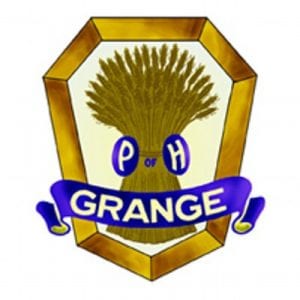About a month ago I received an inquiry from an agriculture teacher in California asking about the origins of the FFA Ceremonies. So the answer to that inquiry forms this Friday’s Footnote. Who is responsible for the FFA ceremonies we have?
In September of 1925, Walter S. Newman, the state supervisor of agricultural education in Virginia, met with three agricultural education faculty members at Virginia Tech. The three faculty members were Harry W. Sanders, Henry C. Groseclose, and Edmund C. Magill. These four individuals discussed the desirability of establishing a statewide organization of students enrolled in vocational agriculture (Arnold, 1953). The idea of establishing the Future Farmers of Virginia (FFV) emerged from that meeting (if you ever visit Virginia Tech stop by the Agricultural Education program to see the table around which these individuals met).
 Photo Source: Robin McLean
Photo Source: Robin McLean
In addition to having taught agriculture, what else did the four individuals have in common? They were all Masons. Walter Newman was a Master Mason. McGill was a Lodge member in Blacksburg, Virginia having transferred from a Lodge in Kansas. Sanders was affiliated with two Lodges in Virginia, and Groseclose is identified with a Lodge near Wytheville, Virginia (Boettjer, 1995).
After the decision was made to move forward with the founding of the FFV, Henry Groseclose took the lead in writing the constitution, degrees, ceremonies, etc. One of the reasons Groseclose had the time to do this was because he was hospitalized in Johns Hopkins Hospital in Baltimore. He entered the hospital on November 10, 1925, and left on May 23, 1926 (Bryant, 2001). During his stay at Johns Hopkins, he had ample time to write the documents that undergirded the FFV and eventually the FFA.
So how do we know the FFA ceremonies were based upon the ceremonies used by Masons? I am not a Mason so I cannot speak from personal experience, but if I were a Mason I would probably not be allowed to speak about Masonic ceremonies since they are secret.

However, in 1995 an article appeared in a Masonic publication that described the FFA ceremonies, degrees, gavel use, and other aspects of a FFA meeting with the clear intent of showing how they were similar to the Masons. The author of the article stated “Clearly, Freemasonry had a key influence on forming the Virginia agricultural boys organization that by 1928 became the Future Farmers of America (Boettjer, 1995, p. 10).
It should be noted that in the discussions of establishing the FFA at regional agricultural education meetings in 1928 the option of having secret ceremonies was discussed and the decision was to avoid secret ceremonies. This decision was reinforced in the first FFA Manual where the responsibilities of local advisors are described, “16. Avoid any form of secrecy in the organization” (FFA Manual, 1929-30, p. 5).
Some might claim that the FFA ceremonies are similar to those of the Grange. Since I am not a member of the Grange, I cannot say. However, I do own a 1929 copy of the Manual of Subordinate Granges of the Patrons of Husbandry. I can see similarities in some of the FFA ceremonies and those of the Grange.
Henry Groseclose was a Mason AND a 7th degree Grange member. It appears Groseclose used both the Masons and the Grange is devising the ceremonies used by the FFA. Hillison and Bryant (2001, p. 109) have delved into the FFA and Grange connection and wrote:
There are several common factors between the Grange and the FFA. Both organizations emblems have had a plow. Both organizations have used an owl. For the Grange the owl means watchful. For the FFA the owl means wise. The Grange and the FFA have used creeds that begin each paragraph with the words I believe. For example, a creed used by the Grange has one paragraph that starts with the sentence “I believe in the goodness of rural life; I will do what I can do to make it still better.” (Creed of a Grange Lecturer, 1930, p. 7) Both organizations have been influenced by the Masonic ritualistic ceremony of opening meetings by a poll of officers reciting duties. All three organizations have an officer who guards the meeting room door. For the Masons the officer is called the tiler, for the Grange the officer is called the gatekeeper, and for the FFA the officer is called the sentinel.

The Grange was established in 1867 and is officially known as the National Grange of the Patrons of Husbandry. The original purpose was to promote education and social interaction of farmers, but the goals rapidly expanded to fighting monopolies (railroads) and promoting cooperative activities. Several of the Grange’s founders were Mason and they incorporated Masonic elements in the organization’s practices. So this leads us directly back to the Masons.
We can conclude the FFA ceremonies were influenced by both the Masons and the Grange.
Teaching Ideas
- There are FFA ceremonies for opening and closing meetings, inducting honorary members and alumni, installing officers, and raising members to the next degree. Have your students write a short ceremony for installing anewFFA advisor. What words of wisdom or advice would your students want to offer?
- If you have a local Grange, you might ask a member to come speak to your classes about the Grange today.
References
Arnold, B. A. (1953). The Man from Virginia. The National Future Farmer, 2, 22-23.
Boettjer. J. W. (1995, July). Freemasonry and the Future Farmers of America. The Scottish Rite Journal.
Bryant, B. W. (2001). History of the Virginia FFA Association. Doctoral Dissertation, Virginia Tech.
FFA Manual (1929-30). National FFA Organization.
Hillison, J. & Bryant, B. (2001). Agricultural Societies as Antecedents of the FFA. Journal of Southern Agricultural Education Research, Volume 51, Number 1.
Past Friday Footnotes can be found at https://footnote.wordpress.ncsu.edu/
